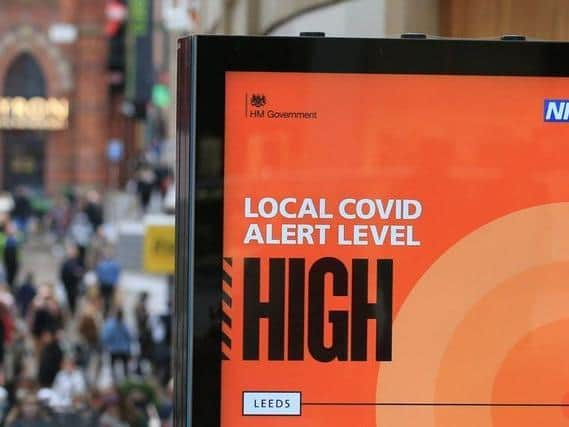When will the Leeds tier be reviewed? City's Covid rate drops further as London surges
and live on Freeview channel 276
The seven-day rolling rate in Leeds is now 137.9 cases per 100,000 people, according to the PA news agency.
That's down from 165.8 per 100,000 during the seven days prior.
Advertisement
Hide AdAdvertisement
Hide AdIt puts Leeds below other Tier 3 areas such as Manchester (171.5) and Birmingham (193.2).


Of the 315 local areas in England, 166 have seen a rise in case rates, 146 have seen a fall, and three are unchanged.
Leeds is now well below several London boroughs, which have jumped to the top of the chart this week, along big rises in Wales.
London is under the more relaxed Tier 2 restrictions, but the case rate Barking and Dagenham is 333.5 and in Tower Hamlets it is 256.2.
The rate for London as a whole is 191 cases per 100,000.
Advertisement
Hide AdAdvertisement
Hide AdThere has been lots of speculation that London will be moved in Tier 3 at the next review.
The Prime Minister’s official spokesman said: ‘It will be reviewed every two weeks, and as you would expect we keep looking at the data continuously’
On 2 December, England reemerged from its second national lockdown, and entered back into the tier system that was in place ahead of the countrywide restrictions.
Those tiers have been updated to be slightly more strict, and many are apprehensive about what impact they will have on their everyday lives.
Advertisement
Hide AdAdvertisement
Hide AdSo how often could the new tiers be reviewed, and how likely is it that places will be ‘downgraded’ to more lenient measures?
Here is everything you need to know.
When is the next tier review?
Currently, it is set out in law that restrictions imposed by the incoming tier system will be reviewed every fortnight.
That means the first review point for the current tier allocations will take place by Wednesday 16 December.
Following that review, regions’ tiers could change, and its possible of areas that continue to make progress in slowing the spread of the disease to be moved down a tier in advance of Christmas.
Advertisement
Hide AdAdvertisement
Hide AdBut just as an area could have less stringent measures imposed upon it with a return to a lower tier, measures could get stricter, if that's what infection levels dictate.
Could tier reviews happen more regularly?
When pressed in the Commons as to whether Covid tier restrictions could be reviewed more often, Health Secretary Matt Hancock said he was “committing to regular reviews” because “we sometimes have to do it more than weekly, especially if cases are shooting up in an area.”
Answering questions from MPs, the Health Secretary said the initial decisions on tiers will be reviewed in a fortnight after they come into force – 16 December – and then regularly after that.
“We are prepared to take those decisions at a lower-tier local authority area level. That is the exception rather than the norm but we will look at it every single week.”
Advertisement
Hide AdAdvertisement
Hide AdHowever, following Mr Hancock's statements, Downing Street confirmed that even though data would be reviewed more regularly, reviews would still only take place every two weeks.
The Prime Minister’s official spokesman said: “It will be reviewed every two weeks, and as you would expect we keep looking at the data continuously.”
When pushed on whether looking at the data continuously meant tiering could change before the two-week review date, he said: “We’ve set out the statutory obligation to review every two weeks in the winter Covid plan.”
And when Mr Hancock’s words were raised he added: “I believe what the Health Secretary was referring to, as I say, was the fact that we continue to monitor the data continuously.
Advertisement
Hide AdAdvertisement
Hide Ad"There are a whole series of structures and meetings that are in place to do that. And they will continue to happen. But as I said it is set out in the Winter Covid Plan that the first review point will be on 16th.”
How are the tiers decided?
Decisions on tiers are made by ministers based on public health recommendations informed by the following factors:
- case detection rate (in all age groups and, in particular, among the over 60s)
- how quickly case rates are rising or falling
- positivity in the general population
- pressure on the NHS – including current and projected NHS capacity – including admissions, bed occupancy and staff absences
Advertisement
Hide AdAdvertisement
Hide Ad- local context and exceptional circumstances such as a local but contained outbreak
If these indicators are not improving, an area may be moved up a tier and if the trajectory improves, the area may move to a lower tier.
Comment Guidelines
National World encourages reader discussion on our stories. User feedback, insights and back-and-forth exchanges add a rich layer of context to reporting. Please review our Community Guidelines before commenting.